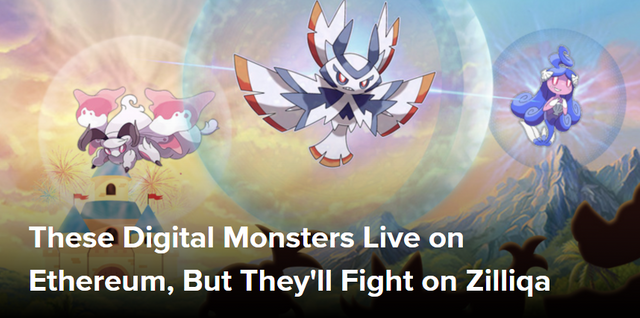These Digital Monsters Live on Ethereum, But They'll Fight on Zilliqa
 (source https://www.coindesk.com/these-digital-monsters-live-on-ethereum-but-they-fight-on-zilliqa/)
(source https://www.coindesk.com/these-digital-monsters-live-on-ethereum-but-they-fight-on-zilliqa/)
Before my one and only "mon" reached level 4, I was out of ether.
Such was the end result of my first experience with Etheremon, a game inspired by Pokemon and built on the world's second-largest blockchain, ethereum. I had around $15 worth of ether to spare, so I decided to try it out, eventually arming myself with a cute, fire-themed creature called Kyari.
But I quickly ran into an issue with the blockchain game. Namely, with $15, I never got a chance to move on to more interesting gameplay: battling other users' mons, "evolving" my mon into more powerful forms, laying eggs or making trades.
Every action, from "catching" the mon (in reality a non-fungible ERC-721 token) to "training" it in gym sessions with other mons (i.e., altering the data associated with that token), had cost the equivalent of a dollar or two.
The reason is that every update to Etheremon's smart contracts calls for "gas," part of a complex fee mechanism that incentivizes the miners who maintain the ethereum blockchain. Making matters worse, these transactions often took several minutes to complete.
Such problems – transactions that cost too much and take too long – are known by the shorthand "scalability" in the blockchain world, and they've caused severe headaches for game designers who want to use a decentralized platform like ethereum.
Poor user experience – which also involves having to buy ether and install a browser extension that can connect to the blockchain – has stunted adoption. Etheremon is the second-most popular ethereum-based game, but that's not saying much. At the time of writing, it's had just 209 users over the previous 24 hours, according to DappRadar.
At one point, gas costs rose so much that Etheremon's developers had to take drastic action.
"It became super, super expensive, and we saw our daily active users drop a lot," co-founder and business development director Nedrick Ngo told CoinDesk.
As a result, the team moved "battles" – in which users pit their mons against others' for experience points and bragging rights – off the ethereum chain and onto centralized servers.
Partially re-centralizing a decentralized game seems like it's missing the point, however, so Etheremon announced earlier this month that it is planning to move much of the gameplay to a new, soon-to-be-launched blockchain protocol called Zilliqa (both Zilliqa's and Etheremon's teams are based in Singapore).
But in a decision that may reflect an emerging trend in the development of decentralized applications (dapps) such as Etheremon, the designers don't plan to move the game's assets. The tokenized "mons" that encode data such as level, experience points and evolutionary form – data that gamers have earned through many slow and costly actions – will stay on ethereum for the time being.
In other words, Etheremon will be one game on two blockchains: a zippier, more scalable chain on top, allowing users to play the game quickly and cheaply; and an (arguably) more secure chain below, providing users with the reassurance that their hard-won assets are safe from attack.
As Ngo put it:
"Zilliqa would work as a side-chain for us."
Zilliqa: sharding from launch
Ethereum's developers have a number of scalability projects in the works. But according to Ngo, Etheremon's team and its users can't wait around for those to be implemented.
"They have to commit Casper and then proof-of-stake and then sharding, so it will take a long time," he told CoinDesk.
Zilliqa, by contrast, is rare if not unique in the world of blockchain protocols, in that it is integrating sharding, a technique that's been used to manage more traditional databases for decades, from the get-go.
This technique is relatively new territory for blockchains, but Zilliqa's team brings serious academic credentials to bear on the problem.
On the other hand, Zilliqa's method of reaching network consensus, practical Byzantine fault tolerance (PBFT), is potentially more vulnerable to certain kinds of attacks than ethereum's proof-of-work method. Unlike bitcoin or ethereum, which are theoretically secure so long as the majority of the nodes follows the rules, PBFT presents a potential limitation, in that it requires two-thirds of nodes to be "honest."
Loom Network offers tools to build dedicated sidechains for decentralized games that are anchored to ethereum, and has begun exploring shared sidechains that host multiple games.
"It's really important to have that decentralized base layer of ethereum," Loom Network co-founder James Duffy told CoinDesk in May, "because then you can use it like the high court."
At the moment, Etheremon and Zilliqa have yet to figure out how exactly to juggle two chains, but Ngo was optimistic, telling CoinDesk this is "just the first stage of the collaboration."